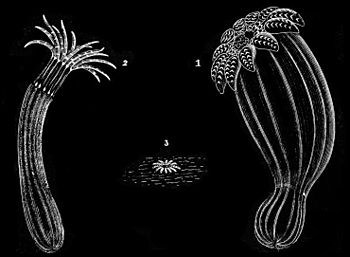to and fro in the water, and with which it can bring the food to its mouth. As soon as a snail or other small animal falls among the fringes, these close around it and move it toward the mouth, where it is soon swallowed, the soft parts digested and the hard parts excluded. By means of its broad base or "foot," the sea-anemone attaches itself
Fig. 2.—Actinia or Sea-Anemones which live in the Sand and are often unattached. 1. Peachia hastata, Gosse.—2. Edwardsia callimorphia, Gosse.—Halocampa chrysanthellum, Gosse—the last mostly buried in the sand.
firmly to the rock or shell on which it rests, and seldom moves from the spot which it has chosen, although it can effect locomotion by means of its "foot." By this it clings so firmly to the rock that it sometimes suffers itself to be torn in two rather than let go its hold.
The main cavity of the body in the sea-anemones is divided by septa or partitions, which run from the top to the bottom, and from the outer wall to the stomach. These partitions or septa are in pairs, and the number is some multiple of six. By what principle of selection this constant number was introduced we may be curious enough to inquire, but we must not expect to receive at once a perfectly satisfactory answer.
The partitions above mentioned are the infolding: of the body-wall of the animal, and are essentially the same as the wall itself. Toward the top of each partition there is a hole, permitting free passage for the water to flow from one chamber to another.


